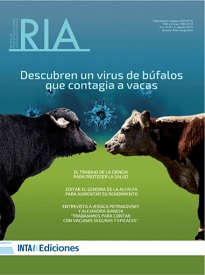Ver ítem
- xmlui.general.dspace_homeCentros Regionales y EEAsCentro Regional Chaco - FormosaEEA Colonia BenítezArtículos científicosxmlui.ArtifactBrowser.ItemViewer.trail
- Inicio
- Centros Regionales y EEAs
- Centro Regional Chaco - Formosa
- EEA Colonia Benítez
- Artículos científicos
- Ver ítem
Evaluación de la intersiembra de rúcula (Eruca sativa Mill.) y lechuga (Lactuca sativa L.) en Colonia Benítez, Chaco
Resumen
El crecimiento demográfico progresivo genera la expansión de los centros urbanos hacia zonas donde comúnmente se ubican los cinturones hortícolas; este aumento poblacional ejerce una fuerte demanda de esas tierras productivas para destinarlas a proyectos de desarrollos urbanísticos. Ante esta situación, es necesaria la aplicación de tecnologías que permitan un mejor aprovechamiento del espacio cultivado, como la práctica de la intersiembra, que consiste
[ver mas...]
El crecimiento demográfico progresivo genera la expansión de los centros urbanos hacia zonas donde comúnmente se ubican los cinturones hortícolas; este aumento poblacional ejerce una fuerte demanda de esas tierras productivas para destinarlas a proyectos de desarrollos urbanísticos. Ante esta situación, es necesaria la aplicación de tecnologías que permitan un mejor aprovechamiento del espacio cultivado, como la práctica de la intersiembra, que consiste en sembrar dos o más especies en la misma superficie para aumentar su productividad. El objetivo de este trabajo fue estudiar el efecto de la intersiembra sobre el rendimiento y características morfológicas en lechuga y rúcula usando diferentes distanciamientos entre líneas, en la localidad de Colonia Benítez, Chaco. Los tratamientos fueron: R= rúcula a 0,2 m entre líneas; L= lechuga a 0,4 m entre líneas; LR1= intersiembra lechuga–rúcula, lechuga a 0,4 m entre líneas y una línea de rúcula entre las líneas de lechuga y LR2= intersiembra lechuga–rúcula, lechuga a 0,4 m entre líneas y dos líneas de rúcula entre las líneas de lechuga. La cosecha de rúcula se realizó a los 30 días después de la siembra (DDS) y la de lechuga
a los 62 DDS, evaluándose el peso fresco aéreo (PF), el peso fresco total (PFT) y la tasa de tierra equivalente (Land Equivalent Ratio; LER), la cual es definida como la superficie total de monocultivo necesaria para lograr el mismo rendimiento que en intersiembra. En ambos cultivos se contó el número total de hojas y en lechuga se midió la longitud de tallo, el peso seco de las hojas y el peso seco del tallo. La mayor producción total se observó en el tratamiento LR1, seguida por LR2 y L. La intersiembra tuvo un efecto negativo sobre el cultivo de lechuga, disminuyendo el rendimiento; este efecto fue mayor cuando fueron dos las líneas de rúcula intersembradas (LR2). En lechuga el número de hojas y la longitud del tallo también se vieron afectados. En LR1 la intersiembra no tuvo efecto en el rendimiento de rúcula; sin embargo, en LR2 el efecto fue negativo, tanto para lechuga como para rúcula. En ninguno de los tratamientos se detectó un efecto sobre el número de hojas de rúcula. El tratamiento de LR1 presentó un LER superior a 1, considerándose que este tratamiento tuvo mejor performance en cuanto a su productividad y calidad de plantas.
[Cerrar]
Progressive demographic growth generates the expansion of urban centers towards areas where horticultural belts are commonly located; this population increase produces a hard demand for these productive lands to be used for urban development projects. Given this situation, it is necessary to apply technologies such as intercropping, that consists of planting two or more species on the same field to increase their productivity. The objective of this work
[ver mas...]
Progressive demographic growth generates the expansion of urban centers towards areas where horticultural belts are commonly located; this population increase produces a hard demand for these productive lands to be used for urban development projects. Given this situation, it is necessary to apply technologies such as intercropping, that consists of planting two or more species on the same field to increase their productivity. The objective of this work was to study the effect of intercropping on yield and morphological characteristics of lettuce and rocket using different distances between rows at Colonia Benítez, Chaco. Treatments were: R=rocket at 0.2 m between rows; L= lettuce at 0.4 m between rows; LR1= lettuce-rocket intercropped, with lettuce at 0.4 m between rows and one row of rocket between lettuce rows and LR2= lettuce-rocket intercropped, with lettuce at 0.4 m between rows and two rows of rocket between lettuce plants. Rocket was harvested 30 days after sowing (DAS) and lettuce 62 DAS, when the above ground fresh weight (FW) and total fresh weight
(TFW) were determined, and land equivalent ratio (LER), defined as the total land area of the sole crop required to achieve the same yields as the intercrops, was calculated. For both crops the total number of leaves was counted and stem length, leaf dry weight and stem dry weight were measured on lettuce. The highest total production was observed in the LR1 treatment, followed by LR2 and L. Intercropping had a negative effect on lettuce, decreasing yield; this effect was greater when there were two lines of rocket (LR2). In lettuce the number of leaves and the length of the stem were also affected. Rocket yield was not affected in LR1, however, in LR2 the effect was negative for both lettuce and rocket. There was no effect on the number of leaves of rocket in any of the treatments. LR1 presented a LER higher than 1. We consider that this was the treatment with the best performance in productivity and plants quality.
[Cerrar]

Fuente
RIA 45 (2) : 252-258 (Agosto 2019)
Fecha
2019-08
Editorial
Ediciones INTA
ISSN
0325-8718
1669-2314
1669-2314
Formato
pdf
Tipo de documento
artículo
Palabras Claves
Derechos de acceso
Abierto
 Excepto donde se diga explicitamente, este item se publica bajo la siguiente descripción: Creative Commons Attribution-NonCommercial-ShareAlike 2.5 Unported (CC BY-NC-SA 2.5)
Excepto donde se diga explicitamente, este item se publica bajo la siguiente descripción: Creative Commons Attribution-NonCommercial-ShareAlike 2.5 Unported (CC BY-NC-SA 2.5)


